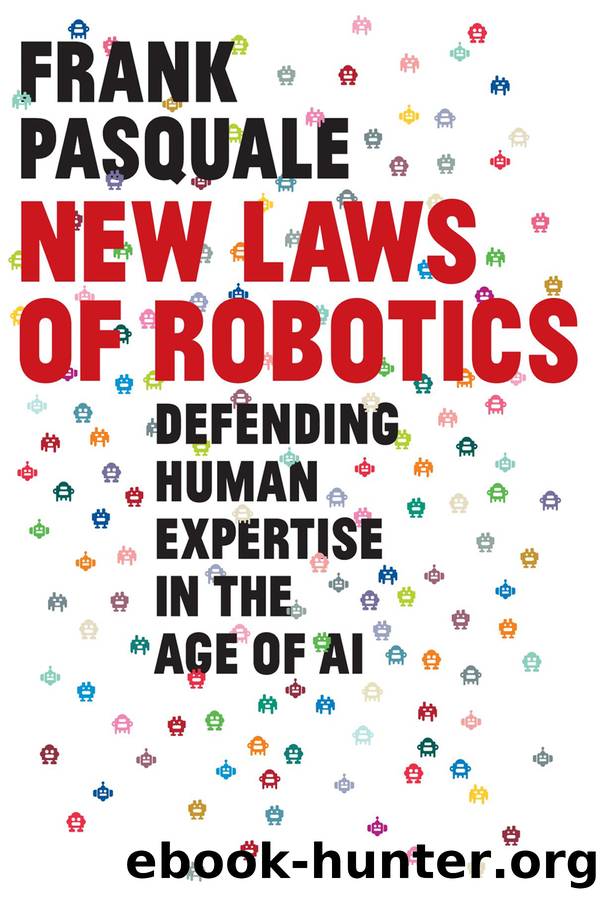New Laws of Robotics by Frank Pasquale

Author:Frank Pasquale
Language: eng
Format: epub
Publisher: Harvard University Press
PATHS TO COOPERATION
Guard labor, including preparations for war, is big business.86 The rise of âterror capitalismâ has turbocharged a thriving global trade in surveillance equipment. The United States is the leading exporter, but other powers are catching up. Chinese firms sell high-tech cameras to British security agencies and the Zimbabwean government.87 Security specialists from around the world shop for wares at the Xinjiang Anti-terrorism Technical Equipment Fair in China.88 Russian military equipment shows up in Syria, Iran, and Mexico. Supposedly private firms stockpile data that is bought, hacked, or coopted by government âfusion centersâ capable of integrating myriad information sources into pattern of life analysis of hundreds of thousands of individuals. Weaponry has always been big business, and an AI arms race promises profits to the tech savvy and politically well-connected.
Counseling against arms races may seem utterly unrealistic. Great powers are pouring resources into military applications of AI. All too many of their citizens either donât care or applaud any ostensible effort to bolster their security (whatever its cost effectiveness).89 Yet that quiescent attitude may change over time as the domestic use of AI surveillance ratchets up, and that guard labor is increasingly identified with shadowy apparatuses of control, rather than democratically accountable local powers.
Military and policing AI is not used only, or even primarily, on foreign enemies. It has been repurposed to identify and fight enemies within. While nothing like the September 11 attacks have emerged over almost two decades in the United States, homeland security forces (especially at the state and local level) have quietly turned anti-terror tools against criminals, insurance frauds, and even protesters. China has hyped the threat of âMuslim terrorismâ to round up a sizable percentage of its Uighurs into reeducation camps and to intimidate others with constant phone inspections and risk profiling. No one should be surprised if some Chinese equipment powers a US domestic intelligence apparatus, while massive US tech firms get coopted by the Chinese government into parallel surveillance projects.
The advance of AI guard labor is less a rivalry among great powers than a globe-encompassing project by corporate and government elites to maintain hegemony over restive populations. The powerful often have far more in common with one another than with the average citizens of their home countries. Jingoistic saber rattling paints a convenient veneer of conflict over a common interest in promoting the stable extraction of value from labor unable to demand a larger share of the economyâs productive gains. To the extent that citizens of the United States, China, and Russia have some influence over the direction of their militaries, they should bear this new divide in mind. Just as we saw in the realm of policing, in war, the acquisition of spectacular new forms of AI-driven force is not a simple story of enhancing the governmentâs power to impose justice. It is also a tool of oppression, using rapid technological advance to freeze into place an unjust status quo.90
Once deployed abroad in battles and occupations, military methods tend to find a way back to the home front.
Download
This site does not store any files on its server. We only index and link to content provided by other sites. Please contact the content providers to delete copyright contents if any and email us, we'll remove relevant links or contents immediately.
| Automotive | Engineering |
| Transportation |
Whiskies Galore by Ian Buxton(41720)
Introduction to Aircraft Design (Cambridge Aerospace Series) by John P. Fielding(33016)
Small Unmanned Fixed-wing Aircraft Design by Andrew J. Keane Andras Sobester James P. Scanlan & András Sóbester & James P. Scanlan(32684)
Craft Beer for the Homebrewer by Michael Agnew(18081)
Turbulence by E. J. Noyes(7894)
The Complete Stick Figure Physics Tutorials by Allen Sarah(7264)
Kaplan MCAT General Chemistry Review by Kaplan(6823)
The Thirst by Nesbo Jo(6759)
Bad Blood by John Carreyrou(6477)
Modelling of Convective Heat and Mass Transfer in Rotating Flows by Igor V. Shevchuk(6354)
Learning SQL by Alan Beaulieu(6159)
Weapons of Math Destruction by Cathy O'Neil(6085)
Man-made Catastrophes and Risk Information Concealment by Dmitry Chernov & Didier Sornette(5877)
Digital Minimalism by Cal Newport;(5588)
Life 3.0: Being Human in the Age of Artificial Intelligence by Tegmark Max(5405)
iGen by Jean M. Twenge(5325)
Secrets of Antigravity Propulsion: Tesla, UFOs, and Classified Aerospace Technology by Ph.D. Paul A. Laviolette(5237)
Design of Trajectory Optimization Approach for Space Maneuver Vehicle Skip Entry Problems by Runqi Chai & Al Savvaris & Antonios Tsourdos & Senchun Chai(4957)
Electronic Devices & Circuits by Jacob Millman & Christos C. Halkias(4865)
